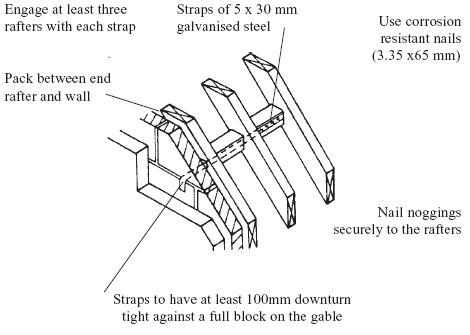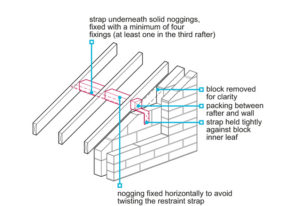

Note that this module does NOT design the ridge strap itself it is simply assumed that the ridge strap is of sufficient strength to keep the rafters connected at the ridge under any uplift conditions.


This is the horizontal plan length, which will only equal the total rafter length if the roof pitch is zero (flat). Usually, this will be half the width of the roof, from eave to ridge. Rafter Plan Length: The horizontal length of a single rafter.
#RAFTER STRAPS UPDATE#
The diagram, an example of which is shown to the right, will update dynamically as each of the inputs are set. The first step in using the calculator is to input the overall geometry. Ridge straps are not designed in this module, but may be added to control the uplift separation. However, a ridge strap has no effect upon gravity load scenario of the walls being pushed outward. However, a tie in any position will help in both scenarios.Īlternatively instead of a collar tie, a ridge strap can also be used to keep the rafters from separating at the ridge. A tie located in the bottom third of the roof, usually called a "rafter tie" (and which may also serve a dual purpose as a ceiling joist), is most efficient in preventing the walls from splaying outwards under downward loading. Ties prevent the walls from being pushed outwards by the roof under downward or gravity loads.Ī tie located in the top third of the roof, usually called a "collar tie" or "collar beam", is most efficient for preventing the rafters from separating at the ridge in uplift loading.Ties prevent the rafters from separating at the ridge in wind uplift loads and.In the design of a gable roof, ties serve two purposes, as illustrated in the graphic on the right: Using the calculator involves three essential steps, and one optional step in which the design can be fine-tuned. All load combinations are checked, and both uplift and downward forces are considered. The wood roof ties calculator is capable of designing the ties and rafter for a gable roof having any combination of collar ties, rafter ties, or ridge straps. If your home does not qualify due to improper nailing or no hurricane straps at all there are companies that can retrofit for you.Wood Roof Ties to NDS 2018 - Usage & Theory Guide Using the Module No more than 1/2″ spacing from the truss.A Strap must wrap over the truss and be nailed on the opposite side.Minimum of 3 nails for clips and straps.To qualify for this discount these connections need to meet a certain criteria: Double straps – 2 metal connectors that wrap over the truss.Strap – Metal connectors that wrap over the truss and are nailed on each side.Clips – Metal connectors that do not wrap over the truss.Toe Nails – When there is no connector present or when a connector does not meet the requirements such as only 2 nails.These connections go in order of worst to best:

There are different forms of hurricane strap and each one has a different discount. It is essentially a bracket or strap of some sorts to prevent your roof from blowing off during high winds. A Hurricane strap is what is referred to on a wind mitigation form as a “Roof to wall attachment”. Home owners think its something added on the house when a new roof is installed and this simply isn’t the case. Many home owners are unaware of this though. Straps have been used on homes dating all the way back to the 1960’s. A Hurricane strap on a home is nothing new.


 0 kommentar(er)
0 kommentar(er)
